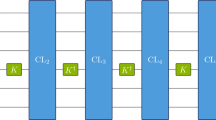Abstract
The famous Johnson–Lindenstrauss lemma states that for any set of n vectors \(\{v_i\}_{i=1}^n \in \mathbb {C}^{d_1}\) and any \(\epsilon > 0\), there is a linear transformation \(T: \mathbb {C}^{d_1} \rightarrow \mathbb {C}^{d_2}\), \(d_2 = O(\epsilon ^{-2} \log n)\) such that \(\left\| { T(v_i) }\right\| _2 \in (1 \pm \epsilon ) \left\| { v_i }\right\| _2\) for all \(i \in [n]\). In fact, a Haar random \(d_1 \times d_1\) unitary transformation followed by projection onto the first \(d_2\) coordinates followed by a scaling of \(\sqrt{\frac{d_1}{d_2}}\) works as a valid transformation T with high probability. In this work, we show that the Haar random \(d_1 \times d_1\) unitary can be replaced by a uniformly random unitary chosen from a finite set called an approximate unitary t-design for \(t = O(d_2)\). Choosing a unitary from such a design requires only \(O(d_2 \log d_1)\) random bits as opposed to \(2^{\varOmega (d_1^2)}\) random bits required to choose a Haar random unitary with reasonable precision. Moreover, since such unitaries can be efficiently implemented in the superpositional setting, our result can be viewed as an efficient quantum Johnson–Lindenstrauss transform akin to efficient quantum Fourier transforms widely used in earlier work on quantum algorithms. We prove our result by leveraging a method of Low for showing concentration for approximate unitary t-designs. We discuss algorithmic advantages and limitations of our result and conclude with a toy application to private information retrieval.
Similar content being viewed by others
Explore related subjects
Discover the latest articles, news and stories from top researchers in related subjects.References
Ailon, N., Chazelle, B.: The fast Johnson–Lindenstrauss transform and approximate nearest neighbors. SIAM J. Comput. 39, 302–322 (2009)
Anderson, G., Guionnet, A., Zeitouni, O.: An Introduction to Random Matrices. Cambridge University Press, Cambridge (2009)
Bellare, M., Rompel, J.: Randomness-efficient oblivious sampling. In: 35th Annual Symposium on Foundations of Computer Science (FOCS), pp. 276–287 (1994)
Ben-Aroya, A., Schwartz, O., Ta-Shma, A.: Quantum expanders: motivation and construction. Theory Comput. 6, 47–79 (2010)
Bluhm, A., França, D.: Dimensionality reduction of SDPs through sketching. Linear Algebra Appl. 563(15), 461–475 (2019)
Brandão, F., Harrow, A., Horodecki, M.: Local random quantum circuits are approximate polynomial-designs. Commun. Math. Phys. 346, 397–434 (2016)
Buhrman, H., Cleve, R., Watrous, J., de Wolf, R.: Quantum fingerprinting. Phys. Rev. Lett. 87, 167902:1-167902:4 (2001)
Buhrman, H., Miltersen, P., Radhakrishnan, J., Venkatesh, S.: Are bitvectors optimal? SIAM J. Comput. 31, 1723–1744 (2002)
Capalbo, M., Reingold, O., Vadhan, S., Wigderson, A.: Randomness conductors and constant-degree lossless expanders. In: 34th Annual ACM Symposium on Theory of Computing (STOC), pp. 659–668 (2002)
Cleve, R., Høyer, P., Toner, B., Watrous, J.: Consequences and limits of nonlocal strategies. In: 19th Annual IEEE Conference on Computational Complexity (CCC), pp. 236–249 (2004)
Coppersmith, D.: An approximate Fourier transform useful in quantum factoring. IBM Research Report RC 19642 (1994). arXiv:1709.07268
Fawzi, O., Hayden, P., Sen, P.: From low-distortion norm embeddings to explicit uncertainty relations and efficient information locking. J. ACM 60(44), 1–61 (2013). https://doi.org/10.1145/2518131
Gavinsky, D., Kempe, J., de Wolf, R.: Strengths and weaknesses of quantum fingerprinting. In: 21st Annual IEEE Conference on Computational Complexity (CCC), pp. 288–298 (2006)
Harrow, A., Montanaro, A., Short, A.: Limitations on quantum dimensionality reduction. In: International Colloquium on Automata, Languages and Programming (ICALP), pp. 86–97 (2011). arXiv:1012.2262
Hastings, M., Harrow, A.: Classical and quantum tensor product expanders. Quantum Inf. Comput. 9(3), 336–360 (2009)
Jain, R., Radhakrishnan, J., Sen, P.: A property of quantum relative entropy with an application to privacy in quantum communication. J. ACM 56, 33:1-33:32 (2009)
Johnson, W., Lindenstrauss, J.: Extensions of Lipschitz mappings into a Hilbert space. Contemp. Math. 26, 189–206 (1984)
Low, R.: Large deviation bounds for \(k\)-designs. Proc. R. Soc. A Math. Phys. Eng. Sci. 465, 3289–3308 (2009). https://doi.org/10.1098/rspa.2009.0232
Mosca, M., Zalka, C.: Exact quantum Fourier transforms and discrete logarithm algorithms. Int. J. Quantum Inf. 2(1), 91–100 (2004)
Newman, I.: Private vs. common random bits in communication complexity. Inf. Process. Lett. 39(2), 67–71 (1991)
Sen, P.: Efficient quantum tensor product expanders and unitary \(t\)-designs via the zigzag product (2018). arXiv:1808.10521
Shor, P.: Polynomial-time algorithms for prime factorization and discrete logarithms on a quantum computer. SIAM J. Comput. 26, 1484–1509 (1997)
Ta-Shma, A.: Storing information with extractors. Inf. Process. Lett. 83(5), 267–274 (2002)
Acknowledgements
I thank Ashley Montanaro for pointing me to his work [14] on compression of quantum states and Johnson–Lindenstrauss lemma during a talk given on a preliminary version of this work at a workshop in CRM, Montréal, Canada, October 2011. I acknowledge Daniel Stilck França for informing me about his work in [5]. I acknowledge support of the Department of Atomic Energy, Government of India, under project no. 12-R&D-TFR-5.01-0500, for carrying out this research work. I thank the anonymous referees for their useful remarks and comments that have helped to improve the paper.
Author information
Authors and Affiliations
Corresponding author
Ethics declarations
Conflict of interest
The author declares that he has no conflict of interest.
Additional information
Publisher's Note
Springer Nature remains neutral with regard to jurisdictional claims in published maps and institutional affiliations.
Rights and permissions
About this article
Cite this article
Sen, P. An efficient superpostional quantum Johnson–Lindenstrauss lemma via unitary t-designs. Quantum Inf Process 20, 312 (2021). https://doi.org/10.1007/s11128-021-03238-2
Received:
Accepted:
Published:
DOI: https://doi.org/10.1007/s11128-021-03238-2




